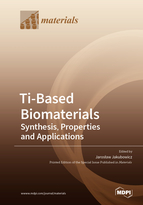Ti-Based Biomaterials: Synthesis, Properties and Applications
A special issue of Materials (ISSN 1996-1944). This special issue belongs to the section "Biomaterials".
Deadline for manuscript submissions: closed (31 December 2019) | Viewed by 64532
Special Issue Editor
Interests: biomaterials; surface treatment; nanomaterials; materials synthesis
Special Issues, Collections and Topics in MDPI journals
Special Issue Information
Dear Colleagues,
In the last half century, great attention has been paid to materials that can be used in the human body to prepare parts that replace failed bone structures. Of all materials, Ti-based materials are the most desirable, because they provide an optimum combination of mechanical, chemical and biological properties.
The successful application of Ti biomaterials has been confirmed mainly in dentistry, orthopedics and traumatology. The Ti provides high strength and a relatively low modulus. Ti biocompatibility is practically the highest of all metallic biomaterials, however new solutions are being sought to improve their biocompatibility and osseointegration. Thus, the chemical modification of Ti results in the formation of new alloys (for example low modulus β-type alloys) or composites (for example with hydroxyapatite), which provide new perspectives for Ti biomaterial applications.
Great attention has also been paid to the formation of nanostructures in Ti-based biomaterials, which has leads to extremely good mechanical properties and very good biocompatibility.
The surface treatment applied to Ti-based biomaterials is required to provide fast osseointegration. Oxide, nitride, DLC or hydroxyapatite surface layers are the most desired and surface technology has been extensively investigated.
Bulk and porous Ti biomaterials, which both have different properties, are used. The introduction of open spaces (voids) into the materials structure is the technological way to reduce the Young’s modulus to a level comparable to human bone.
Over the last years, great attention has been focused on additive technology (3D printing) applied to Ti biomaterials. These processes, such as SLS, SLM or related processes, which use a laser to form the designed chemical composition as well to shape the implant, have gained importance for designing implants for specific patients. The technologies are useful for the formation of bulk, porous as well as gradient biomaterials.
It is my pleasure to invite you to submit a manuscript to this Special Issue that is related to the above topic. Full papers, communications, and reviews are all welcomed.
Prof. Jarosław Jakubowicz
Guest Editor
Manuscript Submission Information
Manuscripts should be submitted online at www.mdpi.com by registering and logging in to this website. Once you are registered, click here to go to the submission form. Manuscripts can be submitted until the deadline. All submissions that pass pre-check are peer-reviewed. Accepted papers will be published continuously in the journal (as soon as accepted) and will be listed together on the special issue website. Research articles, review articles as well as short communications are invited. For planned papers, a title and short abstract (about 100 words) can be sent to the Editorial Office for announcement on this website.
Submitted manuscripts should not have been published previously, nor be under consideration for publication elsewhere (except conference proceedings papers). All manuscripts are thoroughly refereed through a single-blind peer-review process. A guide for authors and other relevant information for submission of manuscripts is available on the Instructions for Authors page. Materials is an international peer-reviewed open access semimonthly journal published by MDPI.
Please visit the Instructions for Authors page before submitting a manuscript. The Article Processing Charge (APC) for publication in this open access journal is 2600 CHF (Swiss Francs). Submitted papers should be well formatted and use good English. Authors may use MDPI's English editing service prior to publication or during author revisions.
Keywords
- Ti-based alloys and composites
- Ti-type bionanomaterials
- Ti bulk and porous biomaterials
- Ti biomaterials surface modification
- Ti additive technology
- Ti new processes
- Ti biomaterials application







